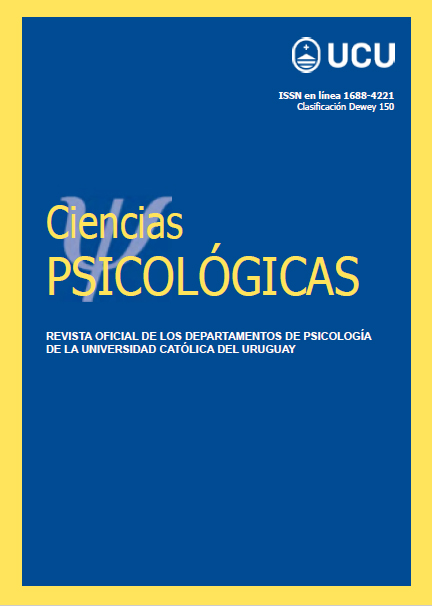Preliminary Evidence of Validity of the Persistent Depressive Disorder Scale (PDD) in Peruvian University Students
DOI:
https://doi.org/10.22235/cp.v19i2.4209Keywords:
Persistent Depressive Disorder, factorial analysis, reliability, factor invarianceAbstract
Persistent Depressive Disorder (PDD), also known as dysthymia, has a chronic course and a negative impact on people's quality of life, even more so in young university students. This disorder is one of the least studied types of mood disorders and lacks instruments for its proper evaluation. Therefore, the main objective of the study was to build a scale to measure PDD and preliminarily evaluate its psychometric properties. The total sample of the study was 868 university students aged 18 to 34 years. The results of the exploratory factor analysis showed the presence of a single factor. Likewise, the confirmatory factor analysis reported adequate goodness-of-fit indices (CFI = .98, TLI = .97, SRMR = .06, RMSEA [90 %CI] = .09 [.08 - .10]) for a single-factor structure. In addition, the scale proved to be invariant according to the sex of the participants. Regarding convergent validity, PDD showed significant covariances with anxiety, depression, and life satisfaction. Finally, the scale showed high reliability (α = .88; ω = .88). In conclusion, the PDD scale preliminarily presents adequate psychometric properties to measure the presence of patterns of persistent depressive disorder in university students.
Downloads
References
Agudelo, D. (2009). Propiedades psicométricas del Inventario de Depresión Estado/Rasgo (IDER) con adolescentes y universitarios de la ciudad de Bucaramanga. Pensamiento Psicológico, 5(12), 139-159. https://doi.org/10.11144/111
Aparcana, F. (2017). La depresión y el rendimiento académico en los estudiantes de la Carrera de Gestión y Negocios del Instituto Superior Sistema Informativo y Soporte Estudiantil (SISE), sede SJL, 2016 [Tesis de maestría]. Universidad Nacional de Educación Enrique Guzmán y Valle. https://repositorio.une.edu.pe/handle/20.500.14039/1367
Argoff, C., & Mccleane, G. (2011). Tratamiento del dolor (3a ed.). Elsevier Mosby.
Arrieta, K., Díaz, S., & González, F. (2014). Síntomas de depresión y ansiedad en jóvenes universitarios: prevalencia y factores relacionados. Revista Clínica de Medicina de Familia, 7(1), 14-22. https://doi.org/10.4321/s1699-695x2014000100003
Asociación Americana de Psiquiatría. (2014). Manual diagnóstico y estadístico de los trastornos mentales (DSM-5).
Ato, M., López, J. J., & Benavente, A. (2013). Un sistema de clasificación de los diseños de investigación en Psicología. Anales de Psicología, 29(3), 1038-1059. https://doi.org/10.6018/analesps.29.3.178511
Auerbach, R. P., Mortier, P., Bruffaerts, R., Alonso, J., Benjet, C., Cuijpers, P., Demyttenaere, K., Ebert, D. D., Green, J. G., Hasking, P., Murray, E., Nock, M. K., Pinder-Amaker, S., Sampson, N. A., Stein, D. J., Vilagut, G., Zaslavsky, A. M., Kessler, R. C., & WHO WMH-ICS Collaborators. (2018). WHO World Mental Health Surveys International College Student Project: Prevalence and distribution of mental disorders. Journal of Abnormal Psychology, 127(7), 623-638. https://doi.org/10.1037/abn0000362
Brown, T. (2008). Confirmatory factor analysis for applied research. The American Statistician, 62(1), 91-92. https://doi.org/10.1198/tas.2008.s98
Calderón, M., Gálvez-Buccollini, J., Cueva, G., Ordoñez, C., Bromley, C., & Fiestas, F. (2012). Validación de la versión peruana del PHQ-9 para el diagnóstico de depresión. Revista Peruana de Medicina Experimental y Salud Pública, 29(4), 578-579. https://doi.org/10.1590/s1726-46342012000400027
Castro-Díaz, S., Gómez-Restrepo, C., Gil, F., Uribe, M., Miranda, C., De La Espriella, M., Arenas, Á., & Pinto, D. (2013). Factores de riesgo para ideación suicida en pacientes con trastorno depresivo en Colombia. Revista Colombiana de Psiquiatria, 43(1), 27-35. https://doi.org/10.1016/j.rcp.2013.11.003
Charlson, F., Ferrari, A., Flaxman, A., & Whiteford, H. (2013). The epidemiological modelling of dysthymia : Application for the Global Burden of Disease Study 2010. Journal of Affective Disorders, 151(1), 111-120. https://doi.org/10.1016/j.jad.2013.05.060
Cheung, G. W., & Rensvold, R. B. (2002). Evaluating goodness-of-fit indexes for testing measurement invariance. Structural Equation Modeling, 9(2), 233-255. https://doi.org/10.1207/S15328007SEM0902_5
Condorcallo, A., & Alvarez, S. (2016). Perfil clínico de personalidad y niveles de resistencia en personas adictas en situación de internamiento [Tesis de grado, Universidad Nacional de San Agustín]. Repositorio Campus UNSA. https://repositorio.unsa.edu.pe/items/23769f41-4fae-4155-bfd0-0f15a7e1d345
Diener, E., Emmons, R., Larsen, E., & Griffin, S. (1985). The satisfaction with sex life scale. Measurement and Evaluation in Counseling and Development, 45(1), 18-31. https://doi.org/10.1177/0748175611422898
Forero, C. G., Maydeu-Olivares, A., & Gallardo-Pujol, D. (2009). Factor analysis with ordinal indicators: A Monte Carlo study comparing DWLS and ULS estimation. Structural Equation Modeling: A Multidisciplinary Journal, 16(4), 625-641. https://doi.org/10.1080/10705510903203573
Franco-Jimenez, R., & Nuñez-Magallanes, A. (2022). Propiedades psicométricas del GAD-7 , GAD-2 y GAD-Mini en universitarios peruanos. Propósitos y Representaciones 10(1), e1437. https://doi.org/10.20511/pyr2022.v10n1.1437
García-Herrera, J., & Nogueras, V. (2013). Guías de autoayuda para la depresión y los trastornos de ansiedad. Servicio Andaluz de Salud. https://consaludmental.org/publicaciones/Guiasautoayudadepresionansiedad.pdf
Ge, P., Tan, C., Liu, J.-X., Cai, Q., Zhao, S.-Q., Hong, W.-Y., Liu, K.-M., Qi, J.-L., Hu, C., Yu, W.-L., Li, Y.-M., You, Y., Guo, J.-H., Hao, M.-Y., Chen, Y., Pan, L.-T., Liu, D.-Y., Yan, M.-Y., Zhang, J.-Z., … Bian, Y. (2024). Prevalence of subthreshold depression and its related factors in Chinese college students: A cross-sectional study. Heliyon, 10(12), e32595. https://doi.org/10.1016/j.heliyon.2024.e32595
Gómez-Restrepo, C. (2015). Encuesta Nacional de Salud Mental – ENSM 2015 - Tomo I. Revista Colombiana de Psiquiatria, 45. https://doi.org/10.1016/j.rcp.2016.09.006
González-Forteza, C., Hermosillo de la Torre, A., Vacio-Muro, M. de los Á., Peralta, R., & Wagner, F. (2015). Depresión en adolescentes. Un problema oculto para la salud pública y la práctica clínica. Boletin medico del Hospital Infantil de Mexico, 72(2), 149-155. https://doi.org/10.1016/j.bmhimx.2015.05.006
Goodheart, C. D., Levant, R. F., Barlow, D. H., Carter, J., Davidson, K. W., Hagglund, K. J., Hollon, S. D., Johnson, J. D., Leviton, L. C., Mahrer, A. R., Newman, F. L., Norcross, J. C., Silverman, D. K., Smedley, B. D., Wampold, B. E., Westen, D. I., Yates, B. T., Zane, N. W., Reed, G. M., … Bullock, M. (2006). Evidence-based practice in psychology. American Psychologist, 61(4), 271-285. https://doi.org/10.1037/0003-066X.61.4.271
Gutiérrez, J. (2020). Trastorno Depresivo Persistente (Distimia) desde la Intervención Cognitivo - Conductual [Tesis de especialidad]. Universidad Pontificia Bolivariana Seccional Bucaramanga. https://repository.upb.edu.co/bitstream/handle/20.500.11912/9316/117_1 %281%29.pdf?sequence=1&isAllowed=y
Halverson, J. (2015). Dysthymic Disorder: Background, Etiology, Epidemiology. Medscape. http://emedicine.medscape.com/article/290686-overview
Mueller, R. O., & Hancock, G. R. (2008). Best Practices in Structural Equation Modeling. En J. Osborne (Ed.), Best Practices in Quantitative Methods (pp. 488-508). Sage. https://doi.org/10.4135/9781412995627.d38
Hayes, A. F., & Coutts, J. J. (2020). Use omega rather than cronbach’s alpha for estimating reliability. But…. Communication Methods and Measures, 14(1), 1-24. https://doi.org/10.1080/19312458.2020.1718629
Hu, L. T., & Bentler, P. M. (1999). Cutoff criteria for fit indexes in covariance structure analysis: Conventional criteria versus new alternatives. Structural Equation Modeling, 6(1), 1-55. https://doi.org/10.1080/10705519909540118
Huarcaya-Victoria, J., De-Lama-Morán, R., Quiros, M., Bazán, J., López, K., & Lora, D. (2020). Propiedades psicométricas del Patient Health Questionnaire (PHQ-9) en estudiantes de medicina en Lima, Perú. Revista de Neuro-Psiquiatria, 83(2), 72-78. https://doi.org/10.20453/rnp.v83i2.3749
Irastorza, L. (2012). Personalidad depresiva: concepto y diferenciación Diagnóstico diferencial entre trastorno de personalidad depresiva y distimia [Tesis doctoral, Universidad Complutense de Madrid]. DOCTA Complutense. https://eprints.ucm.es/id/eprint/15066/1/T24648.pdf
Jiménez-Maldonado, M., Gallardo-Moreno, G., Villaseñor-Cabrera, T., & Gonzáles-Garrido, A. (2013). La distimia en el contexto clínico. Revista Colombiana de Psiquiatría, 42(2), 212-218. https://doi.org/10.1016/s0034-7450(13)70008-8
Klein, D., Schwartz, J. E., Rose, S., & Leader, J. (2000). Five-year course and outcome of dysthymic disorder: A prospective, naturalistic follow-up study. American Journal of Psychiatry, 157(6), 931-939. https://doi.org/10.1176/appi.ajp.157.6.931
Melendres, N. (2019). Prevalencia y factores asociados a Depresión Mayor y/o Distimia en postulantes a la Universidad Nacional De Piura –Perú, 2019 [Tesis de grado]. Universidad Nacional de Piura. http://repositorio.unp.edu.pe/bitstream/handle/UNP/1639/CCS-MEL-HUA-2019.pdf?sequence=1&isAllowed=y
Moreta-Herrera, R., López-Calle, C., Gordón-Villalba, P., Ortiz-Ochoa, W., & Gaibor-Gonzáles, I. (2018). Satisfacción con la vida, bienestar psicológico y social como predictores de la salud mental en ecuatorianos. Actualidades En Psicología, 32(124), 112-126. https://doi.org/10.15517/ap.v32i124.31989
Morocho, G. (2018). Análisis semiológico de la distimia, tomando como referencia los manuales de diagnóstico DSM V y CIE 10. https://repositorio.utmachala.edu.ec/handle/48000/8531
Oliver, A., Galiana, L., & Bustos, V. (2018). Validación de la Escala de Satisfacción con la Vida y su relación con las dimensiones del autoconcepto en universitarios peruanos. Persona, 2(021), 29-44. https://doi.org/10.26439/persona2018.n021.3018
Organización Mundial de la Salud. (2019). Clasificación Internacional de Enfermedades, undécima revisión (CIE-11). https://icd.who.int/browse11
Ortiz, M. (2023). Niveles de depresión y satisfacción con la vida en estudiantes de tercero de bachillerato del colegio Benigno Malo, Post confinamiento por Covid-19, periodo 2021-2022 [Tesis de maestría]. Universidad Politécnica Salesiana de Ecuador. https://dspace.ups.edu.ec/bitstream/123456789/24193/1/UPS-CT010309.pdf
Otzen, T., & Manterola, C. (2017). Técnicas de muestreo sobre una población a estudio. International Journal of Morphology, 35(1), 227-232. https://doi.org/10.4067/S0717-95022017000100037
Oviedo, H., & Campos-Arias, A. (2005). Aproximación al uso del coeficiente alfa de Cronbach. Revista Espanola de Salud Publica, 76(2), 81-84. https://doi.org/10.1590/s1135-57272002000200001
Pavot, W., & Diener, E. (2008). The Satisfaction With Life Scale and the emerging construct of life satisfaction. Journal of Positive Psychology, 3(2), 137-152. https://doi.org/10.1080/17439760701756946
Raykov, T., & Hancock, G. R. (2005). Examining change in maximal reliability for multiple-component measuring instruments. British Journal of Mathematical and Statistical Psychology, 58(1), 65-82. https://doi.org/10.1348/000711005X38753
Rios, J., & Wells, C. (2014). Evidencia de validez basada en la estructura interna. Psicothema, 26(1), 108-116. https://doi.org/10.7334/psicothema2013.260
R-Studio Team. (2021). R Studio: Integrated Development for R (R versión 4.2.2.) [Software]. Rstudio Team Inc.
Sanz, J., Izquierdo, A., & García-Vera, M. (2013). Una Revisión desde la Perspectiva de la Validez de Contenido de los Cuestionarios, Escalas e Inventarios Autoaplicados más Utilizados en España para Evaluar la Depresión Clínica en Adultos [Trabajo académico]. Universidad Complutense de Madrid. https://www.pearsonclinical.es/mwdownloads/download/link/id/879/
Schramm, E., Klein, D. N., Elsaesser, M., Furukawa, T. A., & Domschke, K. (2020). Review of dysthymia and persistent depressive disorder: history, correlates, and clinical implications. The Lancet Psychiatry, 7(9), 801-812. https://doi.org/10.1016/S2215-0366(20)30099-7
Schreiber, J. B., Stage, F. K., King, J., Nora, A., & Barlow, E. A. (2006). Reporting structural equation modeling and confirmatory factor analysis results: A review. Journal of Educational Research, 99(6), 323-338. https://doi.org/10.3200/JOER.99.6.323-338
Sotelo, L., Sotelo, N., Dominguez, S., Poma, I., Cueto, E., Alarcón, D., Barboza, M., & Padilla, O. (2012). Propiedades psicométricas del Inventario de Depresión Estado-Rasgo (IDER) en Adultos de Lima. Avances en Psicología, 20(2), 59-68.
Spielberger, C., Agudelo, D., & Buela-Casal, G. (2008). IDER Inventario de Depresión Estado-Rasgo. MANUAL. TEA. http://www.web.teaediciones.com/Ejemplos/IDER-Manual-Extracto.pdf
Spitzer, R., Kroenke, K., & Williams, J. (1999). Validation and utility of a self-report version of PRIME-MD. Primary Care Companion to the Journal of Clinical Psychiatry, 2(1), 31. https://doi.org/10.1001/jama.282.18.1737
Spitzer, R., Kroenke, K., Williams, J., & Löwe, B. (2006). A brief measure for assessing generalized anxiety disorder: The GAD-7. Archives of Internal Medicine, 166(10), 1092-1097. https://doi.org/10.1001/archinte.166.10.1092
Tapia, R. (2017). La salud mental en el Perú, marco normativo y legislación comparada. Área de Servicios de Investigación, 14(511), 1-49.
The Government of Canada. (2006). The human face of mental health and mental illness in Canada 2006. Minister of Public Works and Government Services Canada. https://www.phac-aspc.gc.ca/publicat/human-humain06/pdf/human_face_e.pdf
Ventura-León, J. (2022). De regreso a la validez basada en el contenido. Adicciones, 34(4), 323. https://doi.org/10.20882/adicciones.1213
Watson, D., Clark, L. A., & Tellegen, A. (1988). Development and Validation of Brief Measures of Positive and Negative Affect: The PANAS Scales. Journal of Personality and Social Psychology, 54(6), 1063-1070. https://doi.org/10.1037/0022-3514.54.6.1063
World Medical Association. (2013). Declaration of Helsinki: Ethical Principles for Medical Research Involving Human Subjects. American Journal of Medicine, 310(20), 2191-2194. https://doi.org/10.1001/jama.2013.281053
Downloads
Published
How to Cite
Issue
Section
License
Copyright (c) 2025 Ciencias Psicológicas

This work is licensed under a Creative Commons Attribution 4.0 International License.
















